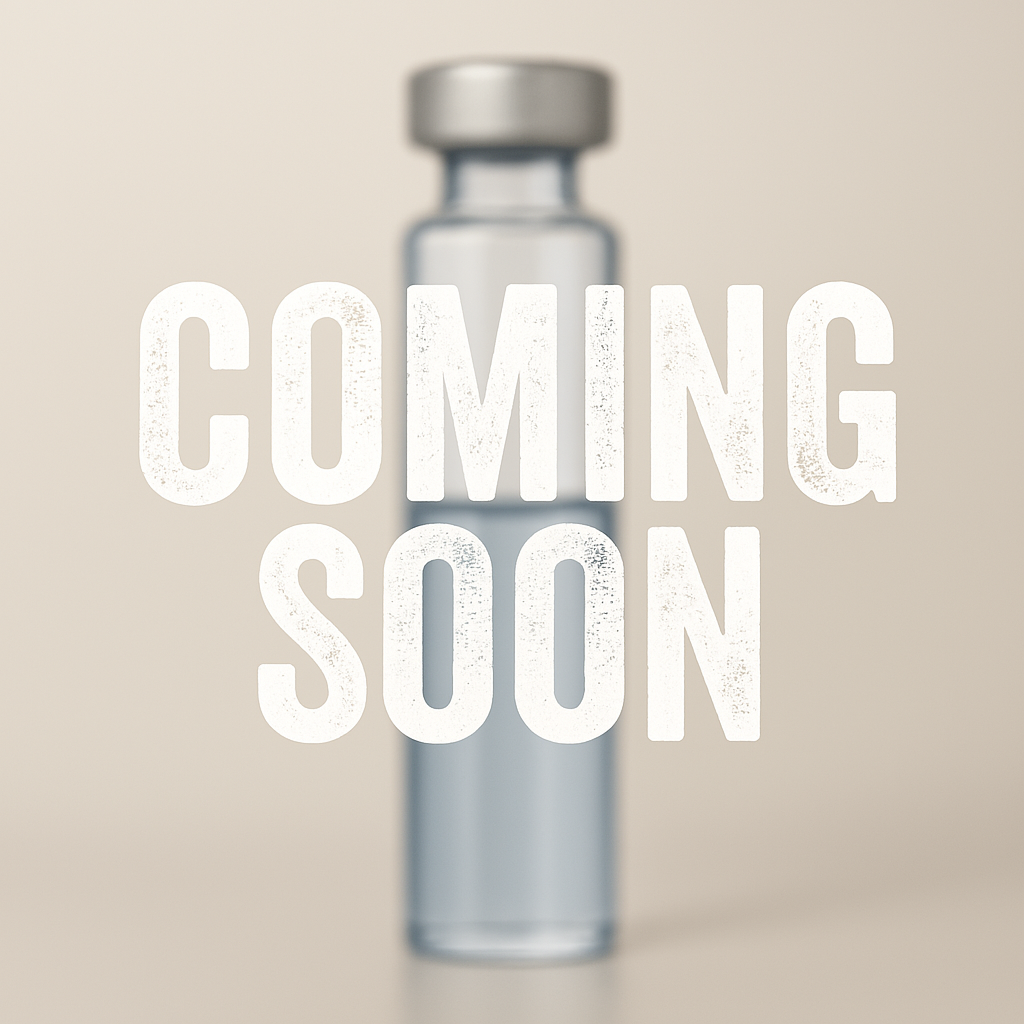Biochem-Peptides
At Biochem Peptides, we are more than just a supplier—we are a family-driven business fueled by a deep passion for peptide therapies. With over five years of dedicated research into the potential and benefits of peptides, our journey led us to establish Biochem Peptides in 2025, built upon a foundation of personal discovery and scientific exploration.
Our commitment extends beyond providing high-quality research chemicals and peptides; we strive to advance understanding and innovation in the field. We believe in the transformative possibilities of peptide therapies, empowering researchers and professionals to explore new frontiers in enhanced living.
At the heart of Biochem Peptides are our core values: trust, loyalty, and respect. These principles guide every aspect of our business, from sourcing premium-grade compounds to fostering long-term relationships with our customers. We are dedicated to transparency, reliability, and ethical practices, ensuring that every interaction upholds the highest standards of integrity.
Biochem Peptides is more than a company—it is a vision for a future where scientific discovery and personal wellness converge.
GHK-Cu 100mg (Lyophilized Vial)
GHK-Cu – Technical Brief (Research-Use-Only) 1. Identity GHK-Cu (Glycyl-L-histidyl-L-lysine copper) is a naturally occurring copper peptide known for its skin regeneration, wound healing, and anti-aging properties. It plays a crucial role in tissue repair and cellular health. 2. Mechanism of Action GHK-Cu works by: - Stimulating collagen and elastin production: Enhances skin firmness and elasticity. - Promoting wound healing: Accelerates tissue repair and reduces scarring. - Acting as an antioxidant: Neutralizes reactive oxygen species (ROS) to protect cells. - Regulating copper-dependent processes: Supports enzymatic functions in skin and hair health. 3. Uses GHK-Cu is primarily researched for: - Skin regeneration: Reduces wrinkles, improves skin clarity, and enhances elasticity. - Wound healing: Accelerates recovery and minimizes scar formation. - Hair growth: Stimulates follicle activity and may help with hair thinning. - Anti-aging: Potential systemic benefits in reversing age-related cellular decline. 4. Dosage Common research protocols include: - Skin regeneration: 1–2% topical serum, applied once or twice daily. - Wound healing: 1–10% solution, applied directly to affected areas. - Hair growth: 0.01–100 nM concentration in topical formulations. - Research applications: typically between 1000 - 2000mcg. - Administered subcutaneously using an insulin syringe once daily. 5. Safety Profile - Common side effects: Mild skin irritation, temporary redness. - Precautions: Generally well-tolerated, but long-term effects require further study. - No systemic toxicity: Unlike some peptides, GHK-Cu does not interfere with hormonal pathways. 6. Storage Guidelines - Before mixing: Store the lyophilized powder in a refrigerator (2–8°C / 36–46°F), protected from light. - After mixing: Keep refrigerated and use within 30–45 days. - Room temperature storage: Can be kept at up to 30°C (86°F) for a maximum of 21 days, but should not be returned to refrigeration afterward. - Do not freeze: Freezing reconstituted vials can degrade the peptide’s integrity. 7. Legality in the UK GHK-Cu is available for research purposes but is not classified as a prescription medication. It is commonly found in cosmetic formulations and anti-aging products, but its use in medical treatments is not officially regulated by the MHRA (Medicines and Healthcare products Regulatory Agency).
£45.00
BPC-157 20MG (Lyophilized Vial)
Body Protection Compound 157 – Technical Brief (Research-Use-Only) 1. Identity BPC-157 (Body Protection Compound-157) is a synthetic peptide derived from a gastric protein, known for its tissue healing, anti-inflammatory, and regenerative properties. It has gained attention for its potential role in muscle recovery, joint repair, and gut health. 2. Mechanism of Action BPC-157 works by: - Promoting angiogenesis: Stimulates the formation of new blood vessels, aiding tissue repair. - Enhancing collagen production: Supports wound healing and joint recovery. - Reducing inflammation: Modulates inflammatory pathways to accelerate healing. - Protecting the gastrointestinal tract: Helps repair gut lining and may aid in conditions like ulcers. 3. Uses BPC-157 is primarily researched for: - Muscle and joint recovery: Supports healing of tendons, ligaments, and cartilage. - Gut health: Potential applications in treating ulcers, leaky gut, and inflammatory bowel conditions. - Neurological protection: Investigated for its role in brain injury recovery. - Anti-inflammatory effects: May help with systemic inflammation and autoimmune conditions. 4. Dosage Common research protocols include: - Subcutaneous injection: 250–500mcg per day. - Oral administration: Some studies suggest effectiveness via oral delivery. - Duration: Typically used for 4–6 weeks in research settings. 5. Safety Profile - Common side effects: Generally well-tolerated, with minimal reported adverse effects. - Precautions: Limited human data; long-term effects require further study. - No known toxicity: Does not interfere with hormonal pathways. 6. Storage Guidelines - Before mixing: Store the lyophilized powder in a refrigerator (2–8°C / 36–46°F), protected from light. - After mixing: Keep refrigerated and use within 30–45 days. - Room temperature storage: Can be kept at up to 30°C (86°F) for a maximum of 21 days, but should not be returned to refrigeration afterward. - Do not freeze: Freezing reconstituted vials can degrade the peptide’s integrity. 7. Legality in the UK BPC-157 is not approved for human consumption in the UK and is classified as a research chemical. It is available for scientific studies but cannot be legally marketed or sold for human use. Regulatory bodies such as the MHRA (Medicines and Healthcare products Regulatory Agency) have not authorized it for medical applications.
£45.00
Melanotan 1
Melanotan 1, also known as afamelanotide, is a synthetic analogue of the alpha-melanocyte-stimulating hormone (α-MSH). It is primarily researched for its ability to stimulate melanin production, offering potential benefits in skin pigmentation, UV protection, and certain dermatological conditions. Mechanism of Action Melanotan 1 works by: • Binding to melanocortin 1 receptors (MC1R): Stimulates melanogenesis, the process by which melanin is produced in the skin. • Enhancing UV protection: Increased melanin acts as a natural barrier against ultraviolet radiation. • Modulating inflammation: May have anti-inflammatory and antioxidant effects through melanocortin pathways. Uses Melanotan 1 is primarily researched for: • Skin pigmentation: Promotes a tan-like effect without excessive sun exposure. • Photoprotection: Used in conditions like erythropoietic protoporphyria (EPP) to reduce UV sensitivity. • Cosmetic tanning: Popular in off-label use for aesthetic skin darkening. • Potential metabolic and neuroprotective effects: Under investigation in early-stage studies. Dosage Research protocols vary, but typical dosing includes: • Initial dose: 0.25–0.5mg subcutaneously per day. • Titration: Gradually increased to 1mg or more depending on response and tolerance. • Maintenance: 1–2 doses per week once desired pigmentation is achieved. • Administration: Subcutaneous injection using an insulin syringe. Safety Profile • Common side effects: Nausea, facial flushing, appetite suppression, and darkening of moles or freckles. • Precautions: Not recommended for individuals with a history of melanoma or atypical skin lesions. • Long-term effects: Still under investigation; caution advised due to limited human data. Storage Guidelines • Before mixing: Store lyophilized powder in a refrigerator (2–8°C / 36–46°F), protected from light. • After mixing: Keep refrigerated and use within 30–45 days. • Room temperature storage: Can be kept at up to 30°C (86°F) for a maximum of 21 days, but should not be returned to refrigeration afterward. • Do not freeze: Freezing may degrade the peptide’s structure. Legality in the UK Melanotan 1 is not approved for medical or cosmetic use in the UK. It is classified as an unlicensed medicine, and the MHRA (Medicines and Healthcare products Regulatory Agency) prohibits its sale, supply, or advertising for human use A. Despite this, it is sometimes found in gyms or online, prompting public health warnings due to safety concerns.
£30.00
Tirzepatide 40mg (Lyophilized Vial)
Tirzepatide – Technical Brief (Research Grade Compound) for Research-Use-Only. 1. Identity Tirzepatide is a dual agonist peptide that targets GLP-1 (glucagon-like peptide-1) and GIP (glucose-dependent insulinotropic polypeptide) receptors. This mechanism enhances metabolic regulation, making it a powerful treatment for type 2 diabetes and obesity management. 2. Mechanism of Action Tirzepatide works by: - GLP-1 activation: Enhances insulin secretion, reduces appetite, and slows gastric emptying. - GIP activation: Supports insulin sensitivity and metabolic balance. 3. Uses Tirzepatide is approved for: - Type 2 diabetes: Improves glucose control and insulin sensitivity. - Obesity management: Helps regulate appetite and energy balance. - Metabolic disorders: Potential applications in lipid metabolism and cardiovascular health. 4. Dosage Standard dosing protocols include: - Week 1–4: 2.5mg once per week. - Week 5–8: 5mg once per week. - Week 9+: 10mg or 15mg once per week (as tolerated). - Administered subcutaneously (abdomen or outer thigh) using an insulin syringe. 5. Safety Profile - Common side effects: Nausea, mild gastrointestinal discomfort, and injection site irritation. - Precautions: Avoid use in individuals with a history of medullary thyroid carcinoma or multiple endocrine neoplasia syndrome type 2. - Long-term effects: Generally well-tolerated, but ongoing studies continue to assess cardiovascular benefits. 6. Storage Guidelines - Before mixing: Store the lyophilized powder in a refrigerator (2–8°C / 36–46°F), protected from light. - After mixing: Keep refrigerated and use within 30–45 days. - Room temperature storage: If necessary, can be kept at up to 30°C (86°F) for a maximum of 21 days, but should not be returned to refrigeration afterward. - Do not freeze: Freezing a reconstituted vial can degrade the peptide’s integrity. 7. Legality in the UK Tirzepatide is approved for type 2 diabetes under the brand name Mounjaro and is available through the NHS. However, its use for weight management is still under evaluation by NICE (National Institute for Health and Care Excellence). Prescribing for obesity is currently restricted, pending further clinical data.
£130.00
Retatrutide 20mg (Lyophilized Vial)
Retatrutide – Technical Brief (For Research-Use-Only) 1. Identity Retatrutide is an investigational peptide designed as a triple agonist, targeting GLP-1 (glucagon-like peptide-1), GIP (glucose-dependent insulinotropic polypeptide), and glucagon receptors. This mechanism enhances metabolic regulation, making it a potential candidate for weight management and diabetes treatment. 2. Mechanism of Action Retatrutide works by: - GLP-1 activation: Enhances insulin secretion, reduces appetite, and slows gastric emptying. - GIP activation: Supports insulin sensitivity and metabolic balance. - Glucagon receptor activation: Increases energy expenditure and fat metabolism. 3. Uses Retatrutide is primarily being researched for: - Obesity management: Helps regulate appetite and energy balance. - Type 2 diabetes: Improves glucose control and insulin sensitivity. - Metabolic disorders: Potential applications in lipid metabolism and cardiovascular health. 4. Dosage While clinical trials are ongoing, suggested dosing protocols for research purposes include: - Week 1–2: 1mg once per week. - Week 3–4: 2.5mg once per week. - Week 5+: 5mg once per week (or as tolerated). - Administered subcutaneously (abdomen or outer thigh) using an insulin syringe. 5. Safety Profile - Common side effects: Nausea, mild gastrointestinal discomfort, and injection site irritation. - Precautions: Avoid use in individuals with a history of medullary thyroid carcinoma or multiple endocrine neoplasia syndrome type 2. - Long-term effects: Still under investigation, but early data suggests a favourable safety profile. 6. Storage Guidelines - Before mixing: Store the lyophilized powder in a refrigerator (2–8°C / 36–46°F), protected from light. - After mixing: Keep refrigerated and use within 30–45 days. - Room temperature storage: If necessary, can be kept at up to 30°C (86°F) for a maximum of 21 days, but should not be returned to refrigeration afterward. - Do not freeze: Freezing a reconstituted vial can degrade the peptide’s integrity. 7. Legality in the UK Retatrutide is not yet approved for use in the UK and is currently undergoing clinical trials. It is unavailable on the NHS, and its future availability remains uncertain due to budget constraints and the presence of other approved weight-loss medications like Mounjaro (tirzepatide) and Wegovy (semaglutide). If approved, it may be prescribed for obesity and type 2 diabetes, pending regulatory approval from the MHRA (Medicines and Healthcare products Regulatory Agency).
£130.00
AOD-9604 5mg (Lyophilized Vial)
AOD-9604 – Technical Brief (Research-Use-Only) 1. Identity AOD-9604 is a modified fragment of human growth hormone (HGH), specifically designed to stimulate fat metabolism without affecting blood sugar levels. It has gained attention for its potential role in weight management and metabolic health. 2. Mechanism of Action AOD-9604 works by: - Stimulating lipolysis: Encourages the breakdown of stored fat. - Inhibiting lipogenesis: Prevents the formation of new fat cells. - Enhancing metabolic activity: Increases energy expenditure without impacting insulin sensitivity. 3. Uses AOD-9604 is primarily researched for: - Fat loss and weight management: Targets stubborn fat deposits. - Metabolic disorders: Potential applications in obesity treatment. - Joint and cartilage repair: Some studies suggest benefits for tissue regeneration. 4. Dosage While clinical data is limited, research protocols often suggest: - Daily subcutaneous injections: 250–500mcg per day. - Alternative administration: Available in nasal spray form for non-invasive delivery. - Duration: Typically used for 8–12 weeks in research settings. 5. Safety Profile - Common side effects: Mild irritation at the injection site, occasional headaches. - Precautions: Generally well-tolerated, but long-term effects require further study. - No impact on IGF-1 levels: Unlike full HGH, AOD-9604 does not stimulate unwanted growth. 6. Storage Guidelines - Before mixing: Store the lyophilized powder in a refrigerator (2–8°C / 36–46°F), protected from light. - After mixing: Keep refrigerated and use within 30–45 days. - Room temperature storage: Can be kept at up to 30°C (86°F) for a maximum of 21 days, but should not be returned to refrigeration afterward. - Do not freeze: Freezing reconstituted vials can degrade the peptide’s integrity. 7 .Legality in the UK AOD-9604 is not approved for medical use in the UK and is classified as a research chemical. It is available for scientific studies but not for human consumption. Regulatory bodies such as the MHRA (Medicines and Healthcare products Regulatory Agency) have not authorized it for therapeutic applications.
£50.00
Cagrilintide 10mg (Lyophilized Vial)
Cagrilintide – Technical Brief (For Research-Use-Only) 1. Identity Cagrilintide is a synthetic peptide designed as a dual amylin and calcitonin receptor agonist (DACRA), developed by Novo Nordisk. It is being researched for its potential role in weight management and type 2 diabetes treatment. 2. Mechanism of Action Cagrilintide works by: - Activating amylin receptors: Enhances satiety and reduces food intake. - Targeting calcitonin receptors: Slows gastric emptying and regulates postprandial glucagon secretion. - Prolonging therapeutic effects: Its modified structure extends its half-life to approximately 7.3 days, allowing for weekly subcutaneous administration. 3. Uses Cagrilintide is primarily researched for: - Obesity management: Helps regulate appetite and energy balance. - Type 2 diabetes: Improves glycemic control and metabolic health. - Combination therapy: Being evaluated alongside semaglutide under the name CagriSema. 4. Dosage While clinical trials are ongoing, suggested dosing protocols for research purposes include: - Weekly subcutaneous injections: Dosage varies based on study parameters starting at 250mcg and titrating up as required - Combination therapy: Often paired with semaglutide for enhanced metabolic effects. 5. Safety Profile - Common side effects: Nausea, mild gastrointestinal discomfort, and injection site irritation. - Precautions: Avoid use in individuals with a history of medullary thyroid carcinoma or multiple endocrine neoplasia syndrome type 2. - Long-term effects: Still under investigation, but early data suggests a favorable safety profile. 6. Storage Guidelines - Before use: Store in a refrigerator (2–8°C / 36–46°F), protected from light. - After mixing: Keep refrigerated and use within 30–45 days. - Room temperature storage: If necessary, can be kept at up to 30°C (86°F) for a maximum of 21 days, but should not be returned to refrigeration afterward. - Do not freeze: Freezing reconstituted vials can degrade the peptide’s integrity. 7. Legality in the UK Cagrilintide is not yet approved for general medical use in the UK but is undergoing clinical trials. It is currently being evaluated by the MHRA (Medicines and Healthcare products Regulatory Agency) for potential therapeutic applications. If approved, it may be prescribed for obesity and type 2 diabetes, pending regulatory decisions.
£80.00
Tesamorelin 10mg (Lyophilized Vial)
Tesamorelin – Technical Brief (For Research-Use-Only) 1. Identity Tesamorelin is a synthetic analogue of Growth Hormone-Releasing Hormone (GHRH), designed to stimulate the release of growth hormone (GH) from the pituitary gland. It has been primarily studied for its role in reducing visceral fat and improving metabolic health. 2. Mechanism of Action Tesamorelin works by: - Binding to GHRH receptors: Stimulates the pituitary gland to release GH. - Mimicking natural GH secretion: Induces a pulsatile release pattern. - Reducing visceral adipose tissue (VAT): Helps manage fat accumulation, particularly in HIV-associated lipodystrophy. 3. Uses Tesamorelin is primarily researched for: - HIV-associated lipodystrophy: Approved for reducing VAT in affected patients. - Metabolic health: Investigated for its role in improving insulin sensitivity and lipid profiles. - Potential cognitive benefits: Some studies suggest neuroprotective effects. 4. Dosage Standard dosing protocols include: - Daily injection: 1mg (1000mcg) subcutaneously. - Reconstitution: A 6mg vial is typically mixed with 2mL of bacteriostatic water. - Administration: Best taken on an empty stomach, as fats and carbohydrates may reduce efficacy. 5. Safety Profile - Common side effects: Mild irritation at the injection site, occasional headaches. - Precautions: Not recommended for individuals with active malignancies. - Long-term effects: Generally well-tolerated, but ongoing studies continue to assess broader applications. 6. Storage Guidelines - Before mixing: Store the lyophilized powder in a refrigerator (2–8°C / 36–46°F), protected from light. - After mixing: Keep refrigerated and use within 30–45 days. - Room temperature storage: Can be kept at up to 30°C (86°F) for a maximum of 21 days, but should not be returned to refrigeration afterward. - Do not freeze: Freezing reconstituted vials can degrade the peptide’s integrity. 7. Legality in the UK Tesamorelin is not approved for general medical use in the UK but is available for research purposes. It is primarily studied for HIV-associated lipodystrophy, but its broader applications remain under investigation. Regulatory bodies such as the MHRA (Medicines and Healthcare products Regulatory Agency) have not authorized it for widespread therapeutic use.
£60.00
Ipamorelin 10mg (Lyophilized Vial)
Ipamorelin – Technical Brief (For Research-Use-Only) 1. Identity Ipamorelin is a synthetic growth hormone secretagogue, designed to stimulate the release of growth hormone (GH) from the pituitary gland. It is known for its selective action, meaning it does not significantly affect cortisol or prolactin levels, unlike other GH-releasing peptides. 2. Mechanism of Action Ipamorelin works by: - Binding to GHRH receptors: Stimulates the pituitary gland to release GH. - Mimicking natural GH secretion: Induces a pulsatile release pattern. - Enhancing muscle growth and recovery: Supports protein synthesis and tissue repair. 3. Uses Ipamorelin is primarily researched for: - Muscle growth and recovery: Supports lean muscle development and repair. - Anti-aging and longevity: Investigated for its role in improving skin elasticity and cellular regeneration. - Fat loss and metabolic health: May aid in reducing adipose tissue. - Neuroprotective effects: Potential applications in cognitive health. 3. Dosage Common research protocols include: - Subcutaneous injection: 200–300mcg per day. - Administration: Typically injected before bedtime to align with natural GH cycles. - Duration: Often used for 8–12 weeks in research settings. 4. Safety Profile - Common side effects: Mild irritation at the injection site, occasional headaches. - Precautions: Generally well-tolerated, with minimal reported adverse effects. - No significant impact on cortisol or prolactin: Unlike other GH secretagogues, Ipamorelin does not cause unwanted hormonal fluctuations. 5. Storage Guidelines - Before mixing: Store the lyophilized powder in a refrigerator (2–8°C / 36–46°F), protected from light. - After mixing: Keep refrigerated and use within 30–45 days. - Room temperature storage: Can be kept at up to 30°C (86°F) for a maximum of 21 days, but should not be returned to refrigeration afterward. - Do not freeze: Freezing reconstituted vials can degrade the peptide’s integrity. 6. Legality in the UK Ipamorelin is not approved for human consumption in the UK and is classified as a research chemical. It is available for scientific studies but cannot be legally marketed or sold for human use. Regulatory bodies such as the MHRA (Medicines and Healthcare products Regulatory Agency) have not authorized it for medical applications.
£35.00
Bacteriostatic Water 0.9% (Liquid)
Bac Water – Technical Brief (Research-Use-Only) 1. Identity Bacteriostatic Water is a sterile, non-pyrogenic solution containing 0.9% benzyl alcohol, which acts as a preservative to inhibit bacterial growth. It is commonly used for diluting medications and peptides before injection. 2. Mechanism of Action Bacteriostatic Water works by: - Preventing bacterial contamination: The benzyl alcohol inhibits microbial growth. - Extending usability: Unlike sterile water, it can be used multiple times within 28 days. - Providing a safe diluent: Used for reconstituting peptides, hormones, and injectable medications. 3. Uses Bacteriostatic Water is primarily used for: - Reconstituting peptides: Ensures sterility when mixing lyophilized powders. - Diluting injectable medications: Used in hormone therapy, vitamin injections, and research 4. applications. - Multi-dose vials: Allows repeated withdrawals without contamination. 5. Dosage - Standard concentration: 0.9% benzyl alcohol in sterile water. - Usage: Typically 1–3ml per vial for peptide reconstitution. - Administration: Used subcutaneously or intramuscularly, depending on the medication. 6. Safety Profile - Common side effects: Mild irritation at the injection site. - Precautions: Not suitable for intravenous injection without additives. - Long-term effects: Generally well-tolerated when used correctly. 7. Storage Guidelines - Temperature: Store at 20–25°C (68–77°F). - Shelf life: Remains sterile for up to 28 days after opening. - Do not freeze: Freezing can degrade the preservative. 8. Legality in the UK Bacteriostatic Water is legal and widely available in the UK for research and medical use. It can be purchased from pharmacies and online suppliers, but regulations may vary depending on its intended application.
£10.00
Disposable Peptide Pen
Benefits of Using Disposable Injector Pens for Peptides Disposable injector pens offer a convenient, precise, and efficient method for administering peptide therapies. Designed with ease of use in mind, these pens simplify peptide delivery, making them ideal for both research applications and personal use. • Precision & Accuracy – Injector pens allow for highly controlled dosing, ensuring consistent administration without the variability of manual syringes. This is especially important when working with peptides that require exact measurements for optimal effectiveness. • Enhanced Sterility & Safety – Each disposable pen is prefilled and sealed, minimizing the risk of contamination. Since they are single-use, there’s no need for repeated handling or potential exposure to environmental contaminants. • Convenience & Ease of Use – Unlike traditional vials and syringes, injector pens streamline the process with a simple, push-button mechanism, reducing the likelihood of user error and making administration quick and hassle-free. • Reduced Waste & Cleanup – With preloaded formulations, there’s no need for additional mixing or preparation, and since the pen is discarded after use, there’s no concern over needle disposal or sterilization. • Portability & Discreet Application – Compact and lightweight, disposable injector pens are easy to transport and use on the go. They provide a discreet and efficient alternative for those who require peptide therapy without the bulk of traditional injections.
£8.00
Reusable Peptide Pen
Benefits of Using Reusable Injector Pens for Peptides Reusable injector pens provide a cost-effective, eco-friendly, and precise solution for administering peptide therapies. Designed for longevity and ease of use, they offer a reliable alternative to traditional injection methods while maintaining accuracy and convenience. • Cost-Effective & Sustainable – Unlike disposable pens, reusable models can be refilled multiple times, reducing overall costs and minimizing environmental waste. They offer long-term savings while maintaining efficiency. • Precision Dosing & Consistency – With adjustable settings, reusable pens ensure accurate dosage delivery, allowing users to fine-tune administration for optimal results. This is especially beneficial for peptides requiring precise measurements. • Sterility & Safety – While reusable, these pens are designed to maintain sterility with replaceable cartridges and needles, reducing the risk of contamination while ensuring proper hygiene with each use. • Ease of Use & Reduced Waste – Built for simplicity, reusable pens streamline the injection process with an intuitive mechanism while eliminating excessive packaging waste associated with single-use options. • Portability & Practicality – Compact and durable, reusable injector pens are ideal for on-the-go applications. Their sturdy design ensures longevity, making them a reliable choice for sustained peptide therapy.
£25.00
Schott 3ml Pen Cartridges
SCHOTT 3 mL pen cartridges, particularly those made from FIOLAX® Type I borosilicate glass, offer several advantages over standard 3 mL cartridges that can elevate both performance and perception: 1. Superior chemical resistance: FIOLAX® glass ensures excellent extractables and leachables profiles, which is crucial for maintaining drug stability—especially with sensitive peptides or biologics A. 2. Tight dimensional no tolerances: SCHOTT cartridges undergo 100% camera inspection, resulting in highly consistent geometries. This improves compatibility with pen injectors and ensures smooth, reliable dosing A. 3. Enhanced break resistance: Their Break Resistant (BR) variants are chemically toughened to withstand mechanical stress—ideal for emergency-use drugs or rugged handling environments A. 4. Optimized for self-administration: These cartridges are designed for accurate, repeatable dosing in pen and auto-injector systems, making them ideal for hormone therapies, diabetes treatments, or research applications where precision matters A. 5. High cosmetic quality: Especially in the TopLine series, SCHOTT offers cartridges with minimal visual defects—important for premium branding and user trust A 6. Ready-to-use options: Their cartriQ® line comes sterile and nested, streamlining fill-and-finish processes and reducing contamination risk A.
£5.00
TikTok
Disclaimer:
The supplier accepts no liability for improper use, misuse, or any consequences arising from the handling, application, or distribution of the products outside of their intended purpose. Customers are solely responsible for ensuring compliance with local regulations and guidelines regarding the purchase and use of research chemicals and peptides.
Any information provided on this website, including descriptions and references, is for educational and informational purposes only and should not be interpreted as guidance for usage beyond research applications.














